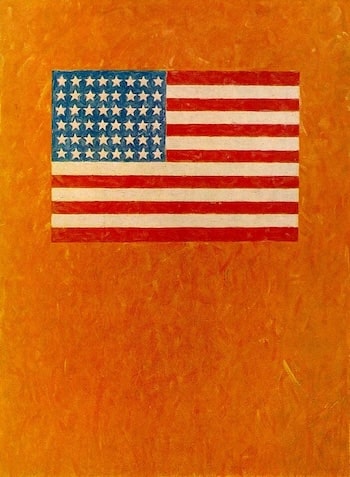Flag on Orange Field, 1957 by Jasper Johns

In an interview some years later, Johns said:
Flag on Orange was involved with how to have more than one element in the painting and how to be able to extend the space beyond the limits of ... the predetermined image... It got rather monotonous, making flags on a piece of canvas, and I wanted to add something - go beyond the limits of the flag, and to have different canvas space. I did it early with the little flags with the white below, making the flag hit three edges of the canvas and then just adding something else. And then in the Orange, I carried it all the way around."
In this straightforward comment, Johns reminds us of the orderly progression of his treatment of images. Dissatisfied with the limits of his self-imposed working arena, he strived to move beyond those limits. How he does so is typical of
his procedures:"I want to add something." He doesn't say he wants to make a break, or that he wants to do something else. Rather he wishes to build - to add to what is already there. In this sense, his approach is fundamentally
conservative.
The critic Barbara Rose has said: "Between the early and later works lie a number of transitional paintings... Perhaps the most important... is the Flag on Orange Field. A punning title, presumably a pun of 'flag' as synonym for
iris... If we accept the flower image established through a pun, Field of Red Poppies by Claude Monet comes to mind as a possible
source for the sunny Impressionist landscape Johns has created. In Flag on Orange Field, several new elements are introduced. Although the flag is still an a priori image, a context, of which the original flags were deprived, is
introduced in the form of the Impressionist field which acts as a frame for the flag.
